Tag: Chest
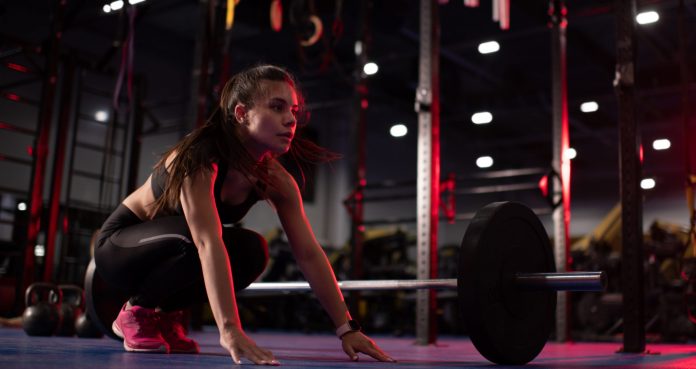
How The Barbell Burpee Will Increase Full Body Strength
This variation of a traditional burpee is great for a workout.
The burpee alone is a challenging workout, let alone adding a bar. One that is comprised of both strength and cardiovascular movements, this workout is the perfect bodyweight exercise to increase full body strength and increase endurance. The burpee is further proof that bodyweight exercises can be just as demanding as any with weights.
But the barbell burpee is unique in that it adds additional elements to an already difficult exercise. Working with a combination of traditional burpee movements including a squat and a pushup, the barbell burpee adds the extra component of a power clean and push press with the barbell to make this is a highly effective exercise to do with a bar.
Used as an aerobic exercise in combination with strength training, the barbell burpee will increase cardio, strength, balance, and flexibility to give you an all-in-one workout to help burn fat and keep you on your feet and working your chest every time for however many reps you want.
Although difficult, the barbell burpee has great benefits and is worth adding to your fitness regimen. Able to attack all of your muscles, including your legs, glutes, core, back, chest, arms, and shoulders, along with the ability to raise your heart rate and get you breathing hard, this burpee is the perfect compound exercise to do with a bar each time.
For those looking to burn fat and increase endurance, as well as aid in power performance, the barbell burpee is great for athletes of any kind. Working many muscles at once also allows you less time working out with the barbell burpee.
All-Around Workout
The barbell burpee allows for increased strength in a variety of muscles including your lower body and upper body. Your legs and glutes are targeted during the jump back into a pushup position as well as the start to the power clean portion of the exercise. Once on the ground, your shoulders provide support as you descend into that all too familiar pushup using the bar as a point of support, especially with the jump up.
With more balance required for the burpee, your core activates and your arms and chest join the workout until that pushup is done as part of this burpee. The fun begins when you lift the barbell into a push press and rely on your fitness to take over as you lower the bar and continue with more reps.
By adding weight, your overall strength increases significantly as opposed to sticking with just your bodyweight (1). As a complex compound exercise, the barbell burpee is sure to fire you up on all cylinders and those gains will really show.
Promotes Fat Burn
As a physically demanding exercise, the barbell burpee is one that will burn off loads of calories, only supported by the fact that so many different muscle groups are being worked. With the ability to increase endurance, your metabolism will work harder for you and your ability to burn more calories will only intensify (2).
Fat loss happens when you consume less than you burn and while dieting can be tricky, the barbell burpee is one exercise to give you a great boost in calorie loss to start you on the right path towards fat loss and the jump and cardio portion of this is great for that.
Increases Endurance
When it comes to increasing your endurance and lung capacity, this workout is one that will do the trick. While running, cycling, or other cardio exercises will get you there as well, the barbell burpee is one that will boost your endurance while at the same time increasing strength and muscle growth (3). A long session of barbell burpees can be all you need for a good day’s work in the gym.
As fatigue sets in, your endurance will allow you to work longer and harder in all other aspects of your training and athletic performance. Along with working your circulatory system, muscular-skeletal system, and central nervous system, the barbell burpee will give your cardiovascular system a great boost to ensure a more effective and longer-lasting lift to add to the rest of your workouts to keep your working hard.
Enhance Explosive Power
Along with increased strength and endurance comes the ability for more power and explosiveness with workouts and competition. Barbell burpees will target your fast-twitch muscle fibers which allow for shorter bursts of speed and power (4). The back and forth jumping into and out of the pushup position mixed with the power of the press at the top will help generate increased speed and power for those looking to get the edge in their workouts.
Having speed and power is not only important for sprinters or jumpers, but for anyone looking to step their game to the next level and this burpee is great for that as you get moving on your hands and feet for a great workout to keep your gains flowing.
Time Efficient
Barbell burpees are time efficient since they include multiple muscles in many muscle groups, as well as targeting your cardio. While you do need a barbell for the barbell burpee, if one is not available, then a traditional burpee will provide almost all of the same benefits. For those who work or feel tight on time in the gym, adding barbell burpees to your workout routine is somewhat of a must.
You will look great, feel better, and know that even if you spent minimal time in the gym and more time off your feet, that you accomplished more with a barbell burpee to keep you doing things you love and start seeing gains.
How To Perform The Barbell Burpee
You will need a barbell and whatever desired weights you want. Place the barbell on the ground and grip the bar with your hands slightly more than shoulder width apart. Kick your legs back into a pushup position and lower to the bar. Push back up to complete the pushup and take your hands off the barbell.
Once on your feet, execute a power clean by lifting the bar to your waist, thrusting to your chest and completing a push press over your head, driving through your feet. Lower to the ground and repeat from the beginning. Keep a tight core and good form throughout to avoid strain or injury from this burpee exercise and rest is important to start seeing growth with all your reps.
Wrap Up
Burpees are never fun and can offer a real challenge for those still working on their fitness. But burpees are a great overall body exercise to get lean and put on muscle while also building a great foundation for endurance. Adding a barbell to the traditional burpee will only add to the fun and increase your gains. The barbell burpee can be challenging and will require balance and flexibility.
You will get better at the barbell burpee and be more fit, only encouraging those gains and increasing your confidence. Don’t let this deter you from maximizing your gains and allow yourself to thrive by adding the barbell burpee to your workout regimen so the rest of your workouts only add to it.
Let us know what you think in the comments below. Also, be sure to follow Generation Iron on Facebook, Twitter, and Instagram.
*Images courtesy of Envato
References
Baker, J. S.; Davies, B.; Cooper, S. M.; Wong, D. P.; Buchan, D. S.; Kilgore, L. (2013). “Strength and Body Composition Changes in Recreationally Strength-Trained Individuals: Comparison of One versus Three Sets Resistance-Training Programmes”. (source)
Ratamess, Nicholas A.; Rosenberg, Joseph G.; Klei, Samantha; Dougherty, Brian M.; Kang, Jie; Smith, Charles R.; Ross, Ryan E.; Faigenbaum, Avery D. (2015). “Comparison of the Acute Metabolic Responses to Traditional Resistance, Body-Weight, and Battling Rope Exercises”. (source)
Kazior, Zuzanna; Willis, Sarah J.; Moberg, Marcus; Apro, William; Calbet, Jose A. L.; Holmberg, Hans-Christer; Blomstrand, Eva (2016). “Endurance Exercise Enhances the Effect of Strength Training on Muscle Fiber Size and Protein Expression of Akt and mTOR”. (source)
Serrano, Nathan; Colenso-Semple, Lauren M.; Lazauskus, Kara K.; Siu, Jeremy W.; Bagley, James R.; Lockie, Robert G.; Costa, Pablo B.; Galpin, Andrew J. (2019). “Extraordinary fast-twitch fiber abundance in elite weightlifters”. (source)
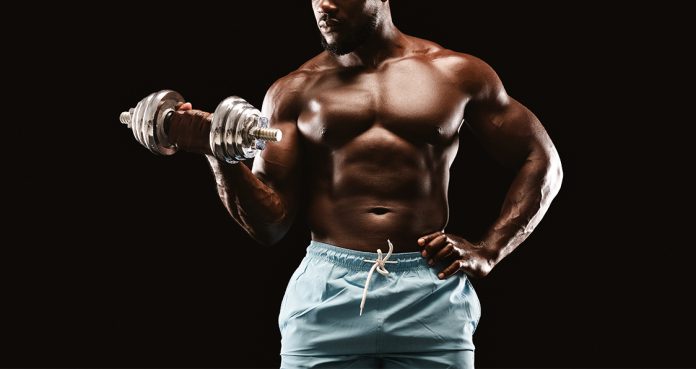
Top 5 Dumbbell Exercises You Should Be Doing
Getting back to the basics
Ah dumbbells. I don’t know about you guys but they remind me of Junior high school. Before all these crazy machines were popular – dumbbells were the way to get strong. Everybody remembers doing dumbbell curls in your friend’s basement with his dad’s weights and thinking “Oh my God I’m so strong, the girls are gonna love this.” Well it’s no secret that dumbbells are just as valuable today as they were back then, if you know how to use them that is.
Dumbbells are great because they provide you with a wide range of motion while lifting as well as being economical on space. You may not have the room to hold a barbell and plates but most of us have enough room for a couple of dumbbells. With that being said, just because you have the equipment doesn’t mean you’re using it to the best of your ability. We’re going to show you some compound exercises to help you get the most out of those barbells and shred your bodies in the process.
Curl and Press
This is a great exercise that combines two singular movements (the bicep curl and shoulder press) in a natural progression movement that will get you strong and lean.
Stand with your feet slightly wider than hip-distance apart. Hold one dumbbell in each hand next to your legs. Face your palms forward with your thumbs farthest from your body.
Exhale, bend your elbows and raise the dumbbells to your shoulders. Inhale and rotate your wrists so that your palms are facing away from your body.
Exhale and lift the dumbbells over your head.
Inhale, bend your elbows and lower the weights to your shoulders. Exhale, rotate your wrists and face your palms toward your body.
Inhale, straighten your arms and lower the weights to your sides into the starting position.
Complete one to three sets of 10 to 15 repetitions. Rest for 45 to 60 seconds in between sets.
Alteration
If you want to up the exercise try starting in a squat position with weights held by your sides ad squat up into the curl and press. Still not enough? Hold the press at the top and squat into that also. After a couple, you’ll feel it.
The Crush Grip Goblet Squat
The goblet squat is a great exercise that was popularized by legendary strength & conditioning coach Dan John. This exercise not only hits all your leg muscles but because of the grip it engages your core and chest.
Stand holding a light dumbbell by the horns close to your chest. This will be your starting position. You want to actively squeeze into the dumbbell either by the head or the body. This activates the chest muscles.
Squat down between your legs until your hamstrings are on your calves. Keep your chest and head up and your back straight.
At the bottom position, pause and use your elbows to push your knees out. Return to the starting position, and repeat for 10-20 repetitions.
Alteration
If you like this exercise you might also want to try the Dumbbell Front Squat. It’s a regular squat but you bend your elbows and put both dumbbells on the meaty part of your shoulders. Pause at the bottom and then come back to starting position. This will strengthen your core as well as giving you strength and stability.
The Dumbbell Bench Press
This exercise is preferred to the the barbell bench press for many bodybuilders. For one, it adds additional difficulty because not only do you have to lift the weight but also balance them individually. This move also allows for a deeper stretch and better symmetry as you can work each side individually.
Sitting on the end of the bench, with the dumbbells resting against your abdomen and thighs, slowly lay back onto the bench. Lift the dumbbells to a position directly over your chest.
Lower the dumbbells until they are slightly lower than your chest and then press the dumbbells to full extension.
After performing your set number of repetitions, lower the dumbbells back to your abdomen and sit back up so the dumbbells are again resting against your thighs and abdomen.
Alteration
If you want to make things interesting try making sure the sides of the dumbbells clink at the top of each extension and then rotate your wrist inward so that the sides of each barbells touch before breaking them back to your chest. This will keep your arms extended longer and the range of motion will hit different muscles.
Bulgarian split squats
This exercise will not only test your strength but your balance. This is a movement that will keep you limber and strong in the off season.
Hold a dumbbell in each hand, stand facing away from a bench, and place the top of one foot on the bench.
Try to keep all the weight on your front (standing) foot as you bend at the knee and descend into a one-legged squat.
Alteration
If you’re feeling froggy try curling the weights either as you go down or when you’re in the up position.
Dumbbell Pullover
You can look at this movement as a back exercise or an upper chest exercise but either way you should incorporate this into your dumbbell repertoire.
Place a dumbbell standing up on a flat bench.
Ensuring that the dumbbell stays securely placed at the top of the bench, lie perpendicular to the bench with only the back of your shoulders touching the bench and your legs holding up your lower body (almost in a back bridge pose) . Hips should be below the bench and legs bent with feet firmly on the floor. The head will be off the bench as well.
Grasp the dumbbell with both hands and hold it straight over your chest with a bend in your arms. Both palms should be pressing against the underside one of the sides of the dumbbell. This will be your starting position.
While keeping your arms locked in the bent arm position, lower the weight slowly in an arc behind your head until you feel a stretch on the chest.
At that point, bring the dumbbell back to the starting position using the arc through which the weight was lowered.
Go back to staring position and continue for your set amount of reps.
Alteration
To direct this exercise toward your chest, keep your elbows close, choke up towards the head of the dumbbell, and concentrate on powering the movement with your hands. To direct it toward your back and lats, let your elbows flair out more and concentrate on using your elbows to power the movement.
There you have it, the top 5 dumbbell workouts that will keep you lean and strong in the off season. Have you tried any of these before? Are we leaving any killer ones out? Let us know.
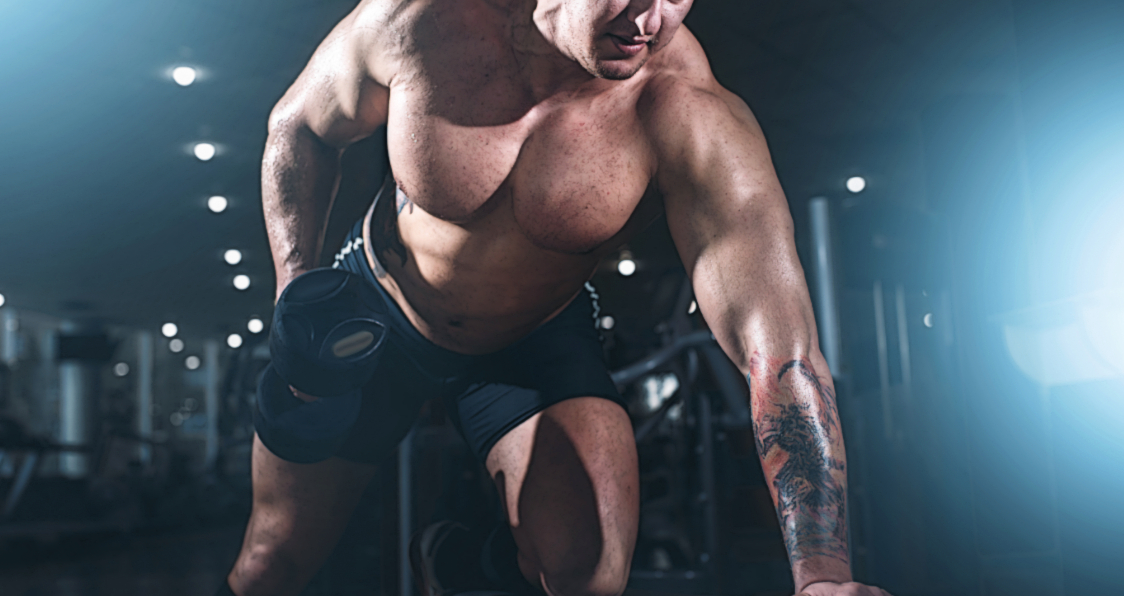
Can’t Afford The Gym? Try The Jailhouse Method
Insane gains the prison way.
In this day and age gyms are more pricey than they’ve ever been before. Many people wish to get into shape and make some serious gains, but their lack of funds keep them from being able to get into the gym and achieve their fitness goals. It can be a bit depressing knowing that you want to make a change, but can’t manage to because of economic interference.
So does that mean you might as well give up and forget about ever making some serious improvements on your body? Hell no! Though machines in the gym do help a great deal in getting your body into ripped and massive condition, that doesn’t mean you can’t make some development without them. When the tools are lacking for the task at hand, the next step is to innovate and do the next best thing. Workout without them.
This is where the concept of the prison workout can help a great deal in improving your physique. For the incarcerated, there aren’t a bunch of fancy machines or dumbbells lying around. For them to improve their strength, muscle endurance, and physique, they must rely on bodyweight exercises to make the difference. So what would a prison workout consist of? For the most part the exercises consist of pushing and pulling motions that will thrash your muscle into shape. We have a list of some prison inspired exercises that are sure to make all the difference to your routine with or without machines.
Upper Body Workout
There are a number of push up and pull up variations that are sure to work your chest, triceps, back and even your core. The key to building up a strong upper body is variety, consistency and attacking different muscle groups with the same intensity. This list of push up and pull up variations will add some variety to your routine and ensure that your muscles are attacked from multiple different angles.
Diamond Push Ups
3 sets, 20 reps
Wide Grip Push Ups
3 sets, 20 reps
Chin Ups
3 sets, 10 reps
Wide Grip Pull Ups
3 sets, 10 reps
Lower Body Workouts
The lower body workout routine is likely to look fairly similar to what you would see in the gym. The lack of weights to give added resistance is a bit of a hurdle to get around, but in exchange for the usual weighted variations, the focus should be on muscle endurance. By the time you’re ready to do a weighted squat the muscle endurance will aid you in pushing some weight.
Body Weight Squat
4 sets, 20 reps
Lunge
4 sets, 10 reps
Calf Raises
4 sets, 25 reps
But you’re still looking to build up muscle then having a training partner for these exercises can be a huge help. For instance, you can have your partner sit on your shoulders during a squat or on your back while doing a calf raise variation (donkey calf raises). They may be a bit more difficult to pull off, but if you’re in a tight situation it should do the trick for muscle growth.
Would you ever use the body weight workout in a bind? Let us know in the comments below and be sure to follow Generation Iron on Facebook and Twitter.
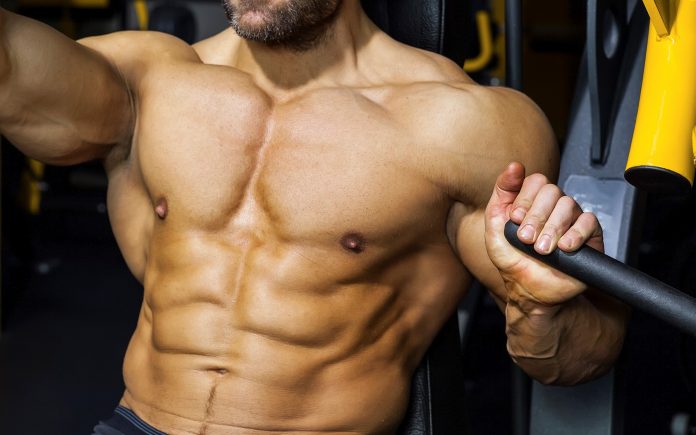
Could This Chest Exercise Be Even Better Than The Bench?
Build up your chest with this awesome exercise.
Chest exercises are pretty obvious at this point. When most bodybuilders look to improve their chest development they focus on a handful of exercises that have been popularized over the years. For our money, the bench press and dumbbell flyes are two of the best exercises you can perform to build a massive and strong chest. At least that’s the school of thought from most trainers and experienced bodybuilders.
That’s not to say that bench press and flyes aren’t the answer to improving your chest game, but as the old saying goes there’s more than one, in this case two, ways to skin a cat. One exercise that could potentially prove to be a better chest exercise than the bench and flyes are dips.
Dips have been at times sited as a potentially damaging exercise for the shoulders by some uninformed fitness gurus, but the reality is that it can greatly improve chest development. We’d go as far to say that it may even be better than if not or equal to the bench press and flyes in its importance and usefulness to chiseling the chest. If you have any doubts, then just take a look at the reasons why you should substitute the bench every now and then.
1. It’s a faster option
Dips are great for the chest for a number of reasons, one of them being that the exercise isolates the chest muscles. The motion for performing the dip requires the user to push in a downward motion with the arms while lifting your body up. The shoulders are also engaged in this motion but are under far less stress when with the bench. Since it’s a bodyweight exercise it also requires more tension and strength from the chest muscles in order to perform the motion. All this combines to making quicker chest gains.
2. Build functional strength along with your chest
Like we mentioned before, the chest dip is a bodyweight exercise. The isolation works great for building muscle specifically in the chest. Besides that however is the fact that you must lift your own body through space which will ultimately translate to core strength. Posture is also important with this exercise.
You body must remain static, your legs must be held in the same position, preferably bent at the knee and crossed. This kind of posture ultimately engages the chest, abs, shoulders, and back, meaning you can get major gains in multiple areas. The body working in concert with other muscles means gaining functional strength for other endeavors, lifting or otherwise.
3. Widens the chest
Another great benefit from doing chest dips is the development in chest width. What separates dips from the bench press and dumbbell flyes is that you’re able to not only work the chest, but work the rest of your upper body as well. As we just mentioned before the dip can engage not only the chest, but the back as well. That includes the upper back as well.
The dip can build the lats up nicely which is the antagonistic muscle to the chest. When you work the antagonistic muscle it allows for better development of the opposite muscle, in this case the chest. All in all, the chest dip is a multifaceted exercise that can work wonders for your entire upper body.
Do you perform chest dips in the gym? Let us know in the comments below and be sure to follow Generation Iron on Facebook and Twitter.
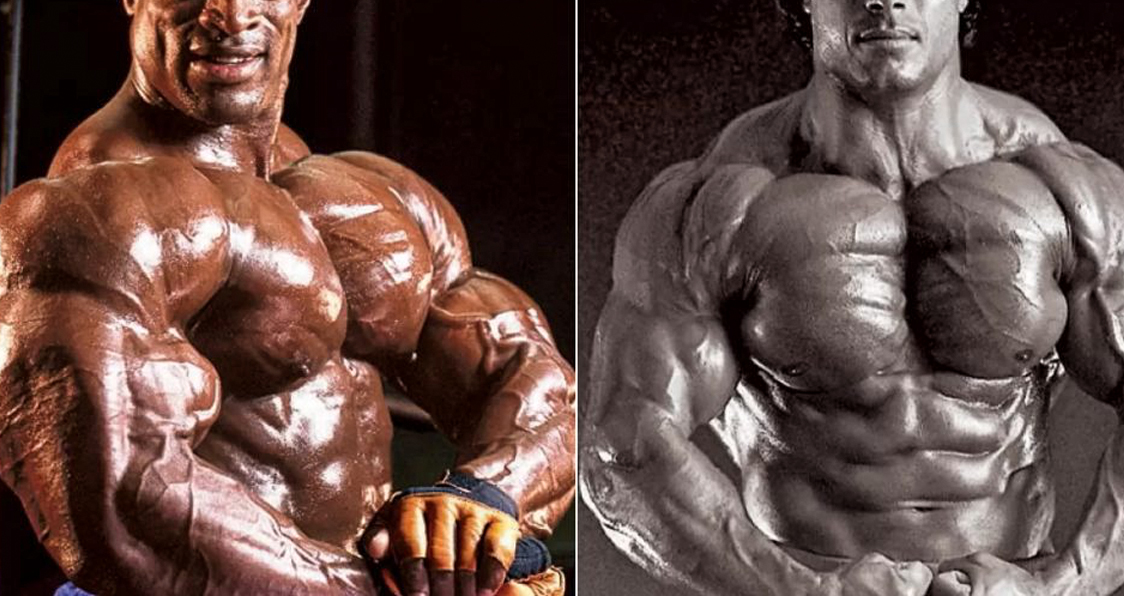
Best on the Planet – Shirt-Ripping Superman Chest
Best Chest in Bodybuilding
A shredded chest is what separates the men from the boys. Superman – with his shirt ripping antics – can arguably be credited for making a broad chest the symbol of machoism.
Why do you need muscular pecs, you ask? A wide chest is the foundation of the ever-so-desired V-taper. There would be no “golden era aesthetics” without symmetrical pectorals. Building a solid chest can take years of hard work and perseverance and this article is our way of honoring people who have achieved the feat.
Arnold Schwarzenegger
The GOAT had one of the best pectoral muscles of his time. The size, fullness, and striations of Arnie’s pecs were unparalleled. His trademark side chest pose is nothing less than a work of art.
Jay Cutler
This article will have a combination of old-school and modern bodybuilders. Cutler’s pecs were a sight to be seen when he dethroned Ronnie Coleman to win his first Mr. Olympia title in 2006.
Serge Nubret
Serge Nubret aka “Black Panther” was a star bodybuilder in the ’60s and ’70s. He took everyone by surprise (including Arnold and Franco) with his incredible symmetry and conditioning in the 1975 Mr. Olympia contest.
Samir Bannout
Samir Bannout is the only bodybuilder from the Middle East to have won a Mr. Olympia title. The size and separation of his pecs made him one of the best bodybuilders of his time. Samir can be credited for popularizing the sport in the Middle East.
Lou Ferrigno
The fact that Lou Ferrigno was cast as The Incredible Hulk should be enough to show that he had one of the most muscular pectorals in the world. Before there were VFX, his size added the ‘incredible’ to the Hulk.
Flex Lewis
Flex Lewis is a freak of nature. He probably has the most symmetrical, proportionate and conditioned physique in the history of bodybuilding. After winning the 212 Mr. Olympia title for seven years in a row, Lewis has been invited to compete in the 2020 Mr. Olympia open division.
Lee Haney
Haney holds the record for winning the most number of Mr. Olympia titles – a tie with Ronnie Coleman. He couldn’t have possibly achieved the feat without having the best pecs in the world.
Franco Columbo
Franco Columbo (RIP) was both swole and strong. The footage of him deadlifting a car out of his way is still a fan favorite. Columbo followed the Governator into bodybuilding and Hollywood and left a mark wherever he went.
Markus Ruhl
It’s a shame that Markus Ruhl’s bodybuilding career ended abruptly due to a squatting accident. He showed a lot of promise, and many top-level bodybuilders considered Ruhl serious competition.
Chris Bumstead
Chris Bumstead reminds many of the ‘Golden Era of bodybuilding’. When bodybuilding fans were worried about the mass monsters taking over the sport, Bumstead came as a ray of hope.
Who do you think has the best chest in the bodybuilding world? Let us know in the comments below. Also, be sure to follow Generation Iron on Facebook and Twitter.
*Header image courtesy of Instagram
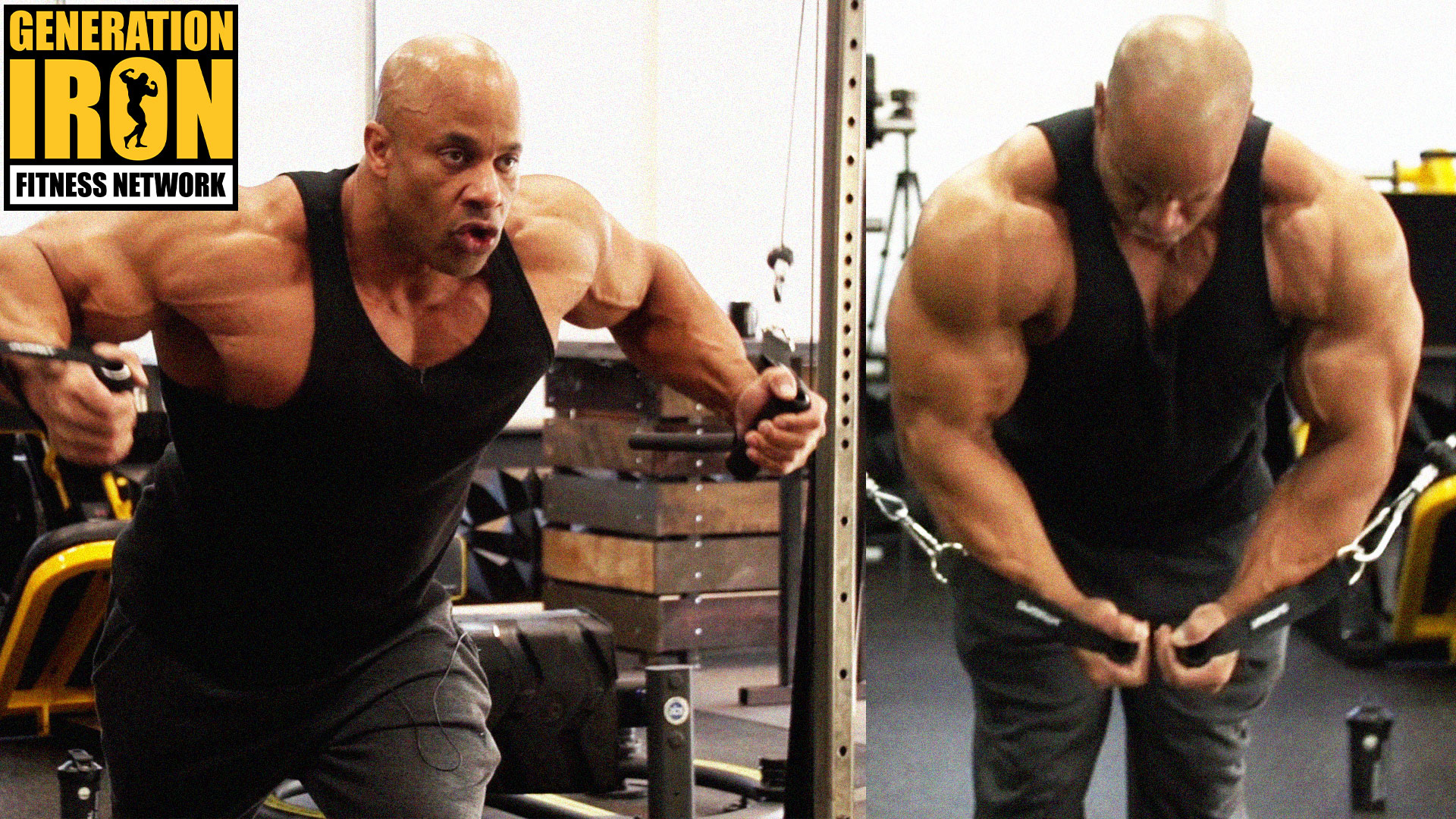
Victor Martinez’s Chest Workout | Training With Victor Martinez (Part 1)
[embedded content]
Victor Martinez’s in-depth chest day training guide.
Victor Martinez is an iconic pro bodybuilder and legend in the sport. He is considered by many to have one of the greatest physiques of the 2000s era of bodybuilders. In 2007, in a controversial decision, he nearly beat Jay Cutler for the Mr. Olympia title. That’s why we met up with Martinez at the Generation Iron Personal Training Gym for an epic workout. In this GI Exclusive, Victor Martinez breaks down in-depth tips to upgrade your chest day training session.
It’s easy enough to find a training routine online – but the real work comes in knowing the details. A list of exercises, sets, and reps is simply the most basic foundation for a successful workout. Knowing proper form, full movement, and specific tips can transform a workout from good to great. It’s what separates a “normal” in shape person from a shredded bodybuilder.
That’s why Victor Martinez met up with Vlad Yudin to go through the ultimate gauntlet of a workout. In part one of our training mini series with Martinez, he puts Vlad through the paces and shares important tips on how to optimize your routine. A workout sheet is one thing – but this video guide will give you play-by-play examples of how to actually perform like a pro bodybuilder.
Victor Martinez’s Chest Day Training Workout
To start, Victor Martinez stresses the important of warm up exercises. Many lifters might want to jump right into the heavy lifting – but warming up not only helps prevent injury, it can allow you to get the most out of your workout and push your muscles to exhaustion. Martinez suggests two warm up exercises with light weight that match the muscle group you’re about to train.
With the warmups out of the way, Victor Martinez decided to focus on three core exercises and break down how to best perform them. Below is the full breakdown of exercises, sets, and reps.
Exercises
Sets
Reps
Chest Press
4
15
Decline Dumbbell Press
4
15
Standing Cable Crossover Flyes
4
15
When it comes to weight, that’s impossible to recommend broadly. Each individual has different limits on how much weight to push. Ultimately, you want to lift enough weight to complete all three sets for each exercise. By the end of the final set for each – you should barely be able to finish. It may take trial and error to begin with – but you’ll ultimately find a sweet spot this will be more than enough to exhaust your muscles completely.
Chest Press (Machine)
For this exercise, Victor Martinez is using an old school chest press machine. He explains how the machine was inspired by football and emulates the kind of moves a linebacker would typically perform on the field. That’s why Martinez suggests sliding down on the seat to give your movements more of an upward momentum. You want to have explosive momentum pushing up, squeeze, and then slowly bring the weight back down in a controlled manner. Avoid locking out your elbows.
Decline Dumbbell Press
For the next exercise, Victor Martinez goes to the classic decline dumbbell press. He suggests that decline presses be done the older you get – as this muscle area tends to lose its fullness as you age. The decline press is also important to provide your chest a full and complete look. Martinez also suggests wide grip dips if you don’t have time to fully commit to a decline press. This also hits the wide areas of the chest.
Standing Cable Crossover Flyes
The final exercise in our Part 1 Victor Martinez workout is the Standing Cable Crossover Flyes. This exercise is a great finisher as it provides focused isolation on the chest. Martinez typically suggests splitting the reps of upper and then lower flyes to best hit the chest from all angles. He also warns of pulling to far back. While many believe this gives a fuller range of motion and a good stretch on the muscle, it can lead to injuring the rotator cuff.
Wrap Up
That about wraps up Part 1 of Victor Martinez’s upper body training routine. Next week, we’ll return to hit up the back in a new selection of exercises. Make sure to watch the GI Exclusive training video above to get complete play-by-play tips on each exercise. Soon you’ll transform your workout into a pro level routine.
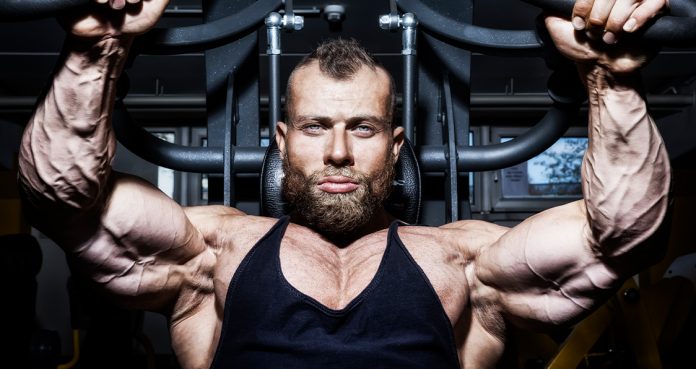
Train Your Inner Chest With This Unique Workout
A unique technique for building your inner chest.
When it comes to training the chest many beginners tackle the issue the wrong way. Some just hit the bench press over and over thinking that it’ll give them the size and definition they seek. Now, that’s not to say that the bench press is the wrong way to go, but it’s definitely not the only exercise you should be doing to build a well defined chest. Though the bench is definitely going to help, it won’t exactly do wonders for all the muscles in your pecs, particularly the inner chest.
We should take a moment to understand the importance of innovation. If we truly wish to develop ourselves into the absolute perfect form we must consider that doing things the same way over and over again can do a number of things. It can teach us to train our bodies in the correct way, giving us a firm foundation that will allow us to continue seeing results. It can also lend itself to restrictive thinking.
Mindset is an important aspect of proper training. If you’ve trained for long enough then you undoubtedly know of the concept of the mind-muscle connection. In order to activate specific muscle groups and get all the muscle fibers firing on all cylinders it’s imperative that we focus all of our mental capacity and attention on what’s being worked. Simply heading to the gym and thinking about the bench press as our sole method for chest training will automatically lead us down a dogmatic mindset, one that closes us off to the countless possibilities.
So if we’re talking about training the chest it can’t just be viewed as the massive slab of muscle that can only be activated in one particular way. Instead we must aim to look at the chest with a broader scope in mind. While we have the outer chest the determines the width of the pec muscle group, there is also the inner chest to consider in order to really bring everything together.
The inner chest is perhaps one of the harder parts of the pecs to develop. With most guys emphasizing building up the width and size of the pecs they often neglect building up the inner walls of the pecs. If a person contracts properly during a bench press or dumbbell flyes they should be able to isolate the tension through the mind muscle connection.
Why train inner chest separate?
So why exactly should we be aiming to train the inner chest in the first place? The reality is that hitting plateaus are all too common in bodybuilding. Every individual, specifically those who have been injured before, marry themselves to an idea, a specific way of training that has always worked for them. While there are some people who rarely have to worry about plateaus, the vast majority must face the reality that doing things the same way can only carry them so far.
Training the inner chest with specific, targeted exercises is only going to further help to bring your chest to the next level, which should always be your goal as a bodybuilder. Whether you’re a top bodybuilder or a novice looking to continue to grow your knowledge, by looking to try new methods of training it means you’re more willing to have an open mind.
There’s nothing worse then closing your mind off to the possibilities. Doing so can only mean doom in your continued journeys as a bodybuilder. If you’re willing to open you mind to one method, then it means you’re willing to open your mind to another. Experimentation after all is a major key to how bodybuilders have gained such success. Trial and error is no doubt a major component to ultimate success.
What method can be tried for better inner chest development?
So far we’ve spoken on the mindset portion of this training method, but not the actual method itself. Activating the inner chest isn’t something you can just do with some dumbbell flyes and call it a day. The requirement is that you’ll have to perform a unique movement that isolates the particular area you wish to grow.
For those looking to attack the inner chest exclusively then there’s an exercise that’s sure to shred the muscle group into shape.
Jeff Cavaliere of Athlean-X fame has gained a ton of popularity in the last several years. As a physical therapist and strength and conditioning coach for some of the greatest athletes in the world, Cavaliere is a man who has garnered a ton of respect in the fitness industry and highly sought after for his expertise.
Cavaliere is the just the kind of man who would sit, contemplate and analyze the chest muscle group to find the solution to a problem few individuals have the answer for. Rather than simply relying on science or experience alone, Cavaliere does his best to combine the two thought processes in order to create something truly unique.
Cavaliere has an exercise that is sure to get the inner chest looking well defined and in the kind of shape that any guy would dream to have. Take a look at Jeff’s unique approach to building up not only the inner chest, but the upper portion of the muscle group as well.
[embedded content]
What is the crossover shrug?
Essentially the crossover shrug works very similar to the dumbbell shrug used to train the traps. But like everything else, the devil is in the details and by rotating the dumbbell inward to activate the inner chest muscles and shrugging with the weight, the movement targets different pec muscle fibers than the regular shrug.
What are the benefits to training this way?
By using this unique method of training we’re able to see that the muscles in the chest can be attacked from different angles. This kind of additional work will likely aid in building up the entirety of the chest and not just simply the inner walls of the pecs.
How should you incorporate this method in your training?
It’s an exercise that can be used as supplementary movement on chest day. Rather than chest hitting flyes, dips, or bench for your chest, this movement can be used as an additional set to give that last bit of work to the muscle on chest day.
For the first few times utilizing this additional movement it would be wise to add in the crossover shrug as a superset to burnout the muscle. Performing one set of this movement on both sides would be ideal. As you become more advanced with the movement and your body begins to adapt, try adding in multiple supersets (either after the main movement or at the end of training) as a means to really punish the muscles into growth.
What’s your opinion on this unique exercise? Do you think it’ll get your pecs into top form?
For more news and updates, follow Generation Iron on Facebook, Twitter, and Instagram.
Managing Editor at Generation Iron, Jonathan Salmon is a writer, martial arts instructor, and geek culture enthusiast. Check out his Instagram, Twitter and Facebook to keep up with his antics.
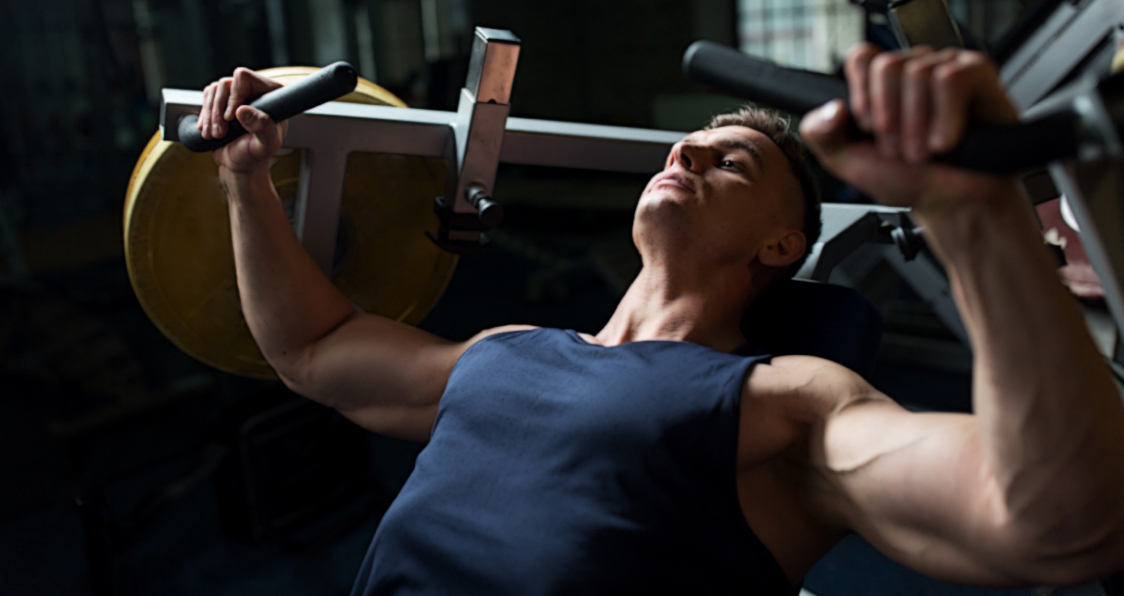
Powerful Chest Building Exercises
The Key To Chest Developing
Chest development is so often high on the priority list for many bodybuilders, powerlifters and gym regulars. There are a number of exercises that we can perform to place significant demand on the muscles of the chest and increase muscular size and strength. In order to develop the chest to its full potential, we must think about incorporating a number of chest strengthening exercises which place an adequate tensity on all muscles of the chest.
The pectorals are the muscle group of the chest which consists of 4 individual muscles that drive and control movement around the shoulder. The two major pectoral muscles are the pectoralis major and the pectoralis minor. The pec major muscle originates from the sternum (front of the ribcage) and clavicle (collarbone) and inserts directly on the humerus of the upper arm. The role of the pec major is to cause flexion, extension and rotation of the humerus (1). The pec minor, meanwhile, lies beneath the pec major, originates from the ribs and inserts on the scapula (shoulder blade). The pec minors role is different from it’s bigger brother as it works to stabilize the scapula.
There are two small muscles of the pecs which are often overlooked – the subclavius and the serratus anterior. As the name suggests, the subclavius can be found underneath the clavicle where it’s role is to depress or “pull” the clavicle down. The serratus anterior originates from the ribs and inserts on the scapula which allows it to pull the shoulder blade forward and around the side of the body.
If we are looking to add mass to the chest, the primary emphasis should be on exercises that challenge the pectoral major – considering it is the biggest muscle of the 4 and therefore has the greatest growth potential. With that being said, if we are looking for comprehensive chest development it’s important to select exercises which target the smaller pectoral muscles too.
The following exercises have been selected simply because they are supreme mass building exercises. However, a further reason for their inclusion is that they all effectively place a high demand on all 4 muscles of the pectorals and contribute to overall chest growth.
The Best Mass Building Chest Exercises
By reading through these 10 chest building exercises, you may quickly notice some similarities and trends. Many of the exercises do replicate the same or similar movement patterns. However, we will use different equipment or a change in the angle of application (i.e adding an incline) to effectively load the pectorals.
You will also find that the vast majority of the exercises are compound or “multi-joint” exercises. Since the goal is mass orientated, it would be appropriate to perform a number of compound lifts considering the substantial impact they have on the body (2). There are a couple of useful isolation or “single-joint” exercises listed, however, their purpose is to facilitate improvement with the compound exercises and iron out any weaknesses.
As stated, a wide range of equipment is utilized – machines, cables, dumbbells, barbells, and body weight. Each piece of equipment will provide a slightly different challenge and training stimulus for the pectorals.
1. Barbell Bench Press
The undisputed king of chest building exercises for a number of reasons. With free weight exercises, you will find that you can lift the heaviest loads when using the barbell, therefore, you can reasonably expect to lift a substantial weight with the barbell bench press. By lifting heavy, we increase the amount of mechanical load that the muscles are exposed to which will drive muscular hypertrophy (growth).
To execute the bench press, lie back on the bench and align your eyes with the barbell. Keeping feet flat on the floor, bring them under the hips to create a slight arch in the lower back. Grip the bar slightly wider than shoulder width to place maximal demand on the pecs. Having a narrower grip will involve the triceps more heavily, taking some demand away from the pecs. Drive hard through the heels and brace the core muscles before removing the bar from the rack and bringing it over the chest. Drop the bar down until it makes contact with the chest and then drive upward to return to the starting position. It is essential to ensure that the elbows are slightly down from the line of the shoulders throughout the duration of the movement. This is done to reduce any risk of shoulder impingement or injury.
If you are new to bench pressing, always start light and practice form first. As you become more competent you can gradually begin to increase the load lifted. Regardless of your experience in lifting, always prioritize safety when benching with the barbell. This means, setting up the rack appropriately to catch the bar in the case of failure or using a spotter to prevent becoming trapped under the bar.
2. Incline Barbell Bench Press
The flat bench press places the body in a position that is parallel with the floor. With the incline bench press, this angle is altered so that the body is placed at incline angle (typically anywhere between 15° and 50°. The purpose of this is to shift the demand to the upper portion of the pectoralis major however, be aware that if the angle is too steep, we will begin to involve the deltoids (shoulders) to a greater extent rather than the pecs (3). Therefore, it would be wise to keep the bench at a low angle in order to hit the upper chest most effectively.
The form for the incline press is identical to the flat press with the only difference between the two being the bench angle. However, don’t expect to bench the same kind of weight with the incline press as you do with the flat press. Because we are utilizing =the upper portion of the pec rather the entirety of the the muscle, you will find the incline press to be more challenging than a flat press.
The standard approach to “chest day”, is often to perform flat bench first before moving onto incline press later in the session. The problem with this approach is that you approach the incline press already in a fatigue state and therefore cannot lift as heavy as you could if you were fresh. With this in mind, I would recommend alternating the variation you start with on a regular basis so that you can perform at an optimal level for both exercises.
3. Dumbbell Bench Press
The dumbbell bench press is an excellent variation of the barbell version. While you will be capable of driving heavier loads with the barbell, there may come a time where you hit a plateau with your benching. At this point, it may be a good idea to switch to the dumbbell bench press which will provide a slightly different stimulus to the pectorals and recommence progress (4).
One of the biggest benefits to dumbbells is the fact that both sides have to work independently which challenges joint stability to large degree. As a result of this instability, a number of stabilizing muscles are recruited in order to control the movement. A further advantage with the dumbbell press is the fact that range of motion is increased. With the barbell press, as soon as the bar touches the chest you must drive back up – there is no physical way to drop any further. With the dumbbells, there is no restriction to stop you from dropping the weights down to the side of the body thus increasing the distance the weight travels and engaging the muscle to an even greater extent.
Finally, the dumbbell bench press may be a good option for beginners or those who are concerned about heavy barbell benching. With the dumbbell press, there is no concern about getting trapped under the bar or failing, as there is with the barbell variation. If you were to reach muscular failure with the dumbbells, you can simply drop them to the floor – no spotter or rack required.
4. Incline Dumbbell Press
As with the barbell press, the dumbbell press can also be completed on an incline bench. Feel free to play around with the angle of the bench which will allow you to target the muscle from a variety of angles and lead to a more comprehensive development.
One variation that can performed with dumbbells that cannot be before with barbells, is the usage of rotation. With a fixed bar, it is impossible to rotate through the shoulder, however, the individual dumbbells allow for a medial rotation of the humerus which causes considerable activation in the pectoralis major.
5. Incline Dumbbell Pullover
The dumbbell pullover is not only an impressive pec developer, but it actually activates a vast number of upper body muscles – including the lats and the delts. The intention with the pullover is to extend maximally through the shoulders, over the top of the head all while maintaining straight arms. This motion demands a great deal of stabilization, control and drive from the pectorals.
To complete the pullover, set a bench up with a slight incline, lie down, start with the dumbbell above the chest and gradually drop the dumbbell over the top of the head without bending at the elbows before returning to the starting position. Remember, this is a single-joint exercise which should be treated as accessory work and therefore be performed towards the end of your session.
6. Machine Chest Press
The primary benefit of using the chest press machine is the fact that the machine requires no stabilization work from the muscles. Because it is a machine, the handles only move in a fixed range, negating the need for muscular stabilization. This, in turn, removes demand from stabilizing musculature, places it all on the pecs and therefore may enhance hypertrophy. If you are looking to gain mass, it would be wise to complete sets on the machine chest press at the end of the session.
7. Machine Decline Press
The machine decline press is another machine based exercise that will hit the pecs from a different angle. The back support is slightly angled backward which places your upper body in a decline position. In the same way in which the incline targets the upper pecs, the decline will hit the lower portion of the pecs.
8. Machine Pec Deck
As with all machine-based exercise, the primary benefit of the pec deck is the fact that it will only follow one path removing the need for muscular stabilization. The machine starts with the handles out to the side of the body. Grasping the handles with straight arms, the pecs must powerfully contract and drive the arms together until they are approximately in line with the shoulders. Despite the different movement patterns, studies have suggested similar muscular activation of the pectorals with both the bench press and pec deck (5).
9. Incline Cable Fly
The incline cable fly is the next stage up from the pec deck machine. Simply, the chest fly is one of best single-joint exercises for isolating the muscles of the chest. The benefits of using cables for the fly is the fact that, unlike with free weights, the cable maintains tension on the pectorals throughout the entirety of the movement which will apply a large amount of stress to the muscle and enhance muscle growth.
10. Chest Dips
The only bodyweight exercise that makes the cut is the chest dip. This can be performed grounded or suspended; having the feet on the ground simplifies the exercise while holding the entire body of the floor presents a greater challenge. In order to target the chest, ensure you go with a wide grip as a narrow grip will place too much stress on the triceps rather than the pecs. The idea is to flex at the elbow and drop the body down towards the floor until the upper arm is parallel with floor. From there, the pecs and triceps must powerfully contract to drive the body back up to the starting position.
Final Word
Understandably, it will be challenging, if not impossible, to program in all 10 exercises into your training. Instead, adopt a small number of these exercises, integrate them into your strength program and be consistent with your training to bring about significant changes in chest size and strength.
For more news and updates, follow Generation Iron on Facebook, Twitter, and Instagram.
References:
1- Solari, Francesca; Burns, Bracken (2019), “Anatomy, Thorax, Pectoralis Major Major”, StatPearls, StatPearls Publishing, PMID 30252247,
2-Paoli, Antonio; Gentil, Paulo; Moro, Tatiana; Marcolin, Giuseppe; Bianco, Antonino (December 22, 2017). “Resistance Training with Single vs. Multi-joint Exercises at Equal Total Load Volume: Effects on Body Composition, Cardiorespiratory Fitness, and Muscle Strength”. Frontiers in Physiology. 8. doi:10.3389/fphys.2017.01105. ISSN 1664-042X. PMC PMCPMC5744434. PMID 29312007.
3-Travi, Alexandre. “Effects of Variations of the Bench Press Exercise on the EMG Activity of Five Shoulder Muscles”.
4-Welsch, Elizabeth A.; Bird, Michael; Mayhew, Jerry L. (2005-5). “Electromyographic activity of the pectoralis major and anterior deltoid muscles during three upper-body lifts”. Journal of Strength and Conditioning Research. 19 (2): 449–452. doi:10.1519/14513.1. ISSN 1064-8011. PMID 15903389.
5-Stastny, Petr; Gołaś, Artur; Blazek, Dusan; Maszczyk, Adam; Wilk, Michał; Pietraszewski, Przemysław; Petr, Miroslav; Uhlir, Petr; Zając, Adam (February 7, 2017). “A systematic review of surface electromyography analyses of the bench press movement task”. PLoS ONE. 12 (2). doi:10.1371/journal.pone.0171632. ISSN 1932-6203. PMC PMCPMC5295722. PMID 28170449.
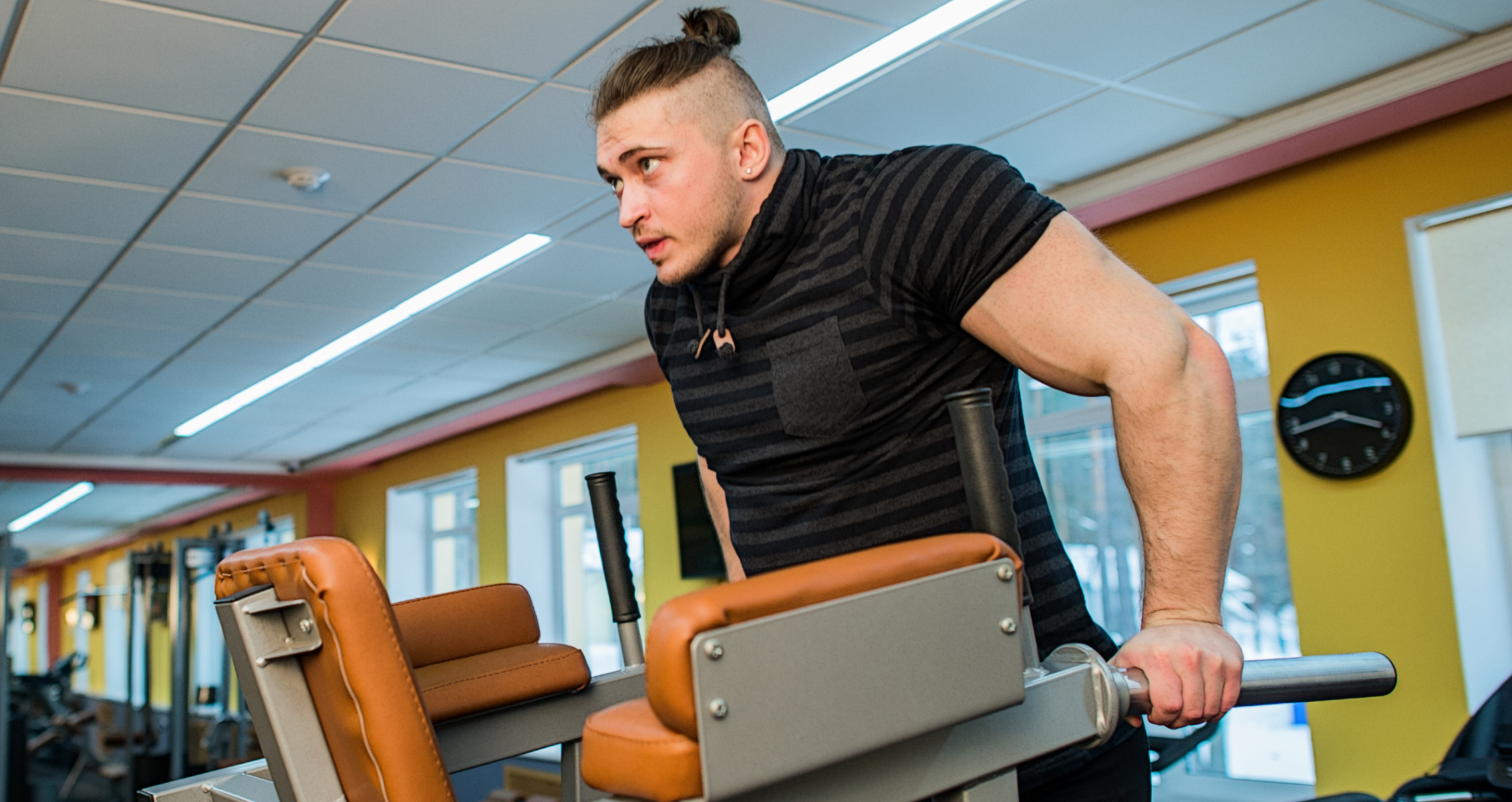
The Eight Best Bodyweight Exercises for the Chest
Most guys can’t imagine a chest workout that doesn’t include a bench and a set of dumbbells or kettlebells. A bodyweight chest workout? Please. There are only so many pushups you can do.
But in a time-crunched, mobile world – pandemic or no pandemic – it’s important to have an effective go-to workout that’s portable and can be done with little or no equipment. That way you can train wherever, whenever. Studies suggest it’s possible to get results without investing in equipment or a gym membership, just your body weight.
8 Bodyweight Chest Exercises
This 8-exercise, two-set circuit will challenge your chest with only your body as resistance. We’ll alternate pushing and pulling movements so you keep moving without rest, providing an aerobic component to your training as well.
Cat/Cow
What it does: This familiar compound yoga move improves flexibility to the lumbar and cervical spine but it also opens up the chest, which is especially important if you’re training after a long day of sitting.
How to do it: Start on all fours with hands beneath your shoulders and knees on the ground. Inhale, dropping your chest as you push your hips and shoulder blades back into cow position. Lift your chin and chest and gaze forward. For cat, exhale as you draw your belly button to your spine and round your back toward the ceiling like a cat.
How many? 2 sets of 10 reps.
Dips
What it does: You use your chest, along with your triceps and biceps, to lift your entire body weight.
How to do it: Position yourself above and between parallel bars, grabbing them with an overhand grip. Cross your ankles behind you. Lower yourself slowly and push back up in a controlled manner. Bodyweight workouts tend to be done without equipment or at least outside the gym. So, this can be performed on steps, a stable chair, or even the floor.
How many? 2 sets of 10 reps.
90/90 Stretch
What it does: Like Cat/Cow, this move opens up the chest but more from a rotational standpoint. It serves as an effective warm-up for this or any other chest workout.
How to do it: Lie on the ground on your left side with legs tucked into the torso at a 90-degree angle. Keep both arms straight parallel to your knees. Keeping the knees together and on the ground, rotate your chest and right arm to the right, putting your back on the ground. Hold for two seconds and return to starting position.
How many? 2 sets of 10 reps to each side.
Plank-to-Pushup
What it does: This combines two effective chest-blasting, core-strengthening moves in one.
How to do it: Begin in a forearm plank position. Push from your triceps, placing your right hand on the ground and then your left hand, gradually rising to pushup position. Return to the forearm plank by placing your right forearm down and then your left.
How many? 2 sets of 10 reps.
Straight Leg Lowering
What it does: This hamstring stretch also challenges the muscles of the chest and torso.
How to do it: Lie flat on your back with arms at your sides and legs straight up above your hips. Keeping one leg straight, slowly lower the other to just above the floor. Return to the starting position and repeat. The key is to keep toes pointed toward your shins and back flat on the floor. Do 10 per side.
How many? 2 sets of 10 per side with 30 seconds rest between sets.
3-Way Pushups
What it does: By doing three sets of 10 pushups in three different positions consecutively, we’re ramping up this workout quickly while challenging our chest and shoulders from three angles.
How to do it: Do 10 traditional pushups (hands directly below the shoulders) followed by 10 “diamond” pushups (index fingers and triceps touching), followed by 10 wide-grip pushups (hands wider than the shoulders)
How many? 10 reps of each.
Plank
What it does: This promotes overall core stability, but your chest and biceps are keeping you in the proper position.
How to do it: Lie in a prone pushup position with hands on the floor, elbows under shoulders and bent 90 degrees. Push up off the elbows, tucking your chin so your head is in line with your body. Keep head in line with spine and belly button drawn in. Hold for one minute.
How many? 2 sets of 60 seconds with 60 seconds rest between sets.
Burpees
What it does: It’s a full-body push-up-like exercise that gives you all the benefits of pushups while also challenging your cardiovascular system and ratcheting up the intensity of your workout, which is especially important when you only have 15 minutes.
How to do it: From a standing position, squat, place your hands on the ground, and “jump” your feet out into a push-up position. Perform a pushup and then jump your feet to your hands. Then jump as high as you can, throwing your hands over your head.
How many? 2 sets of 10 reps.
Pete Williams is a NASM-CPT and the author or co-author of several fitness books, including Core Performance and Every Day is Game Day. His work has appeared in publications such as Men’s Health, Men’s Journal, and USA Today.
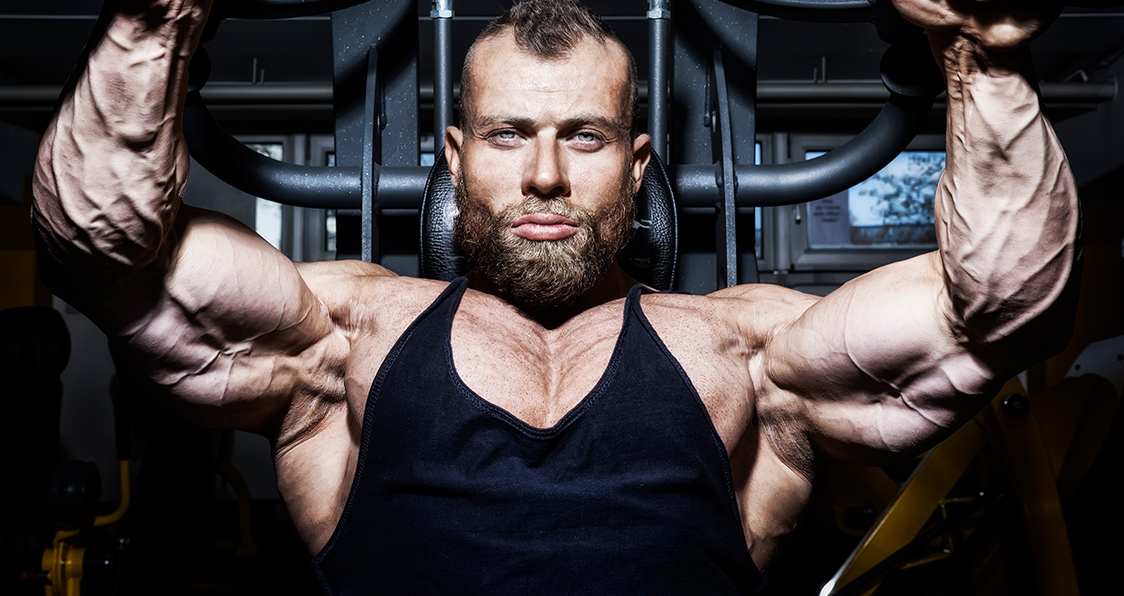
Build a Chest of Steel With This Workout
Workout For a Bigger and Striated Chest
If you’re planning to make a statement with your physique, moobs surely aren’t going to help your case. Having a broad chest can make you stand apart from the crowd and get the attention you deserve.
Building a ripped chest takes more than doing a few pushups and presses. You need to have a combination of compound and isolation exercises in your workouts to develop the perfect size and conditioning.
Cable Crossovers – 4 Sets 15 Reps
You’ll be starting this workout with an isolation exercise to pre-exhaust your pecs before you get into the compound lifts. Exhausting your chest at the beginning of the workout eliminates the need for lifting super heavyweights to recruits and target your pectoral muscles later in the workout.
Grab a D-handle attachment in each hand and take a long stride with either of your feet to get in position for the exercise. Make sure there is tension on your pecs at the starting position. Maintain a slight bend in your elbows while performing the cable crossovers to target your pecs efficiently.
Barbell Bench Press – 4 Sets 15 Reps
The barbell bench press is what squats are for the legs. If you’re new to resistance training or are using a challenging weight, it’s wise to get the help of a spotter. The barbell bench press is a great exercise to build strength and volume in your pectoral muscles.
While performing the bench press, keep your elbows slightly angled towards your sides to eliminate any tension on your rotator cuffs. Contract your pecs with every repetition while performing the exercises in the workout.
Incline Dumbbell Flyes – 3 Sets 15-12-10 Reps
For the majority of people, the upper chest is a weak muscle group. It’s harder to establish a mind-muscle connection with the upper pecs as it’s a very small (one-third of your chest) muscle group.
The key while performing the incline bench dumbbell flyes is to contract your pecs at the top of the movement and target the inner chest. Maintain a slight bend in your elbows and push your chest out as you reach the bottom of the movement.
Decline Dumbbell Press – 3 Sets 15-12-10 Reps
The decline dumbbell press is an incredibly effective exercise in building the separation between your chest and the abdomen. You’ll be able to lift relatively heavier weights in the decline presses as compared to the flat and incline presses.
The dumbbells should be at the sides of your chest at the bottom of the movement. Pause and contracts the life out of your pecs at the top of the movement. While the pressing movements help in developing the size in your chest, the flyes target the separation and conditioning.
Barbell Rollout Flyes – 3 Sets 10 Reps
The barbell rollout flyes are the ultimate chest workout finisher. If you’re lacking the separation between your pecs, the barbell rollout flyes should be a part of your exercise arsenal.
Place a weight plate at each end of a barbell and place the barbells parallel to each other on the floor. Get into a push-up position in the center of the two barbells and grab the barbells with a neutral (palms facing each other) grip.
Your arms should be extended in a straight line and the barbell should be under your shoulders at the starting position. Slowly push the barbell away while mimicking the dumbbell fly movement.
Your chest should be a 5-6 inches away from the floor at the bottom of the movement. Return to the starting position and squeeze your pecs. Repeat for the recommended repetitions.
Which is your favorite chest exercise? Let us know in the comments below. Also, be sure to follow Generation Iron on Facebook and Twitter.
Header image courtesy of Envato Elements
